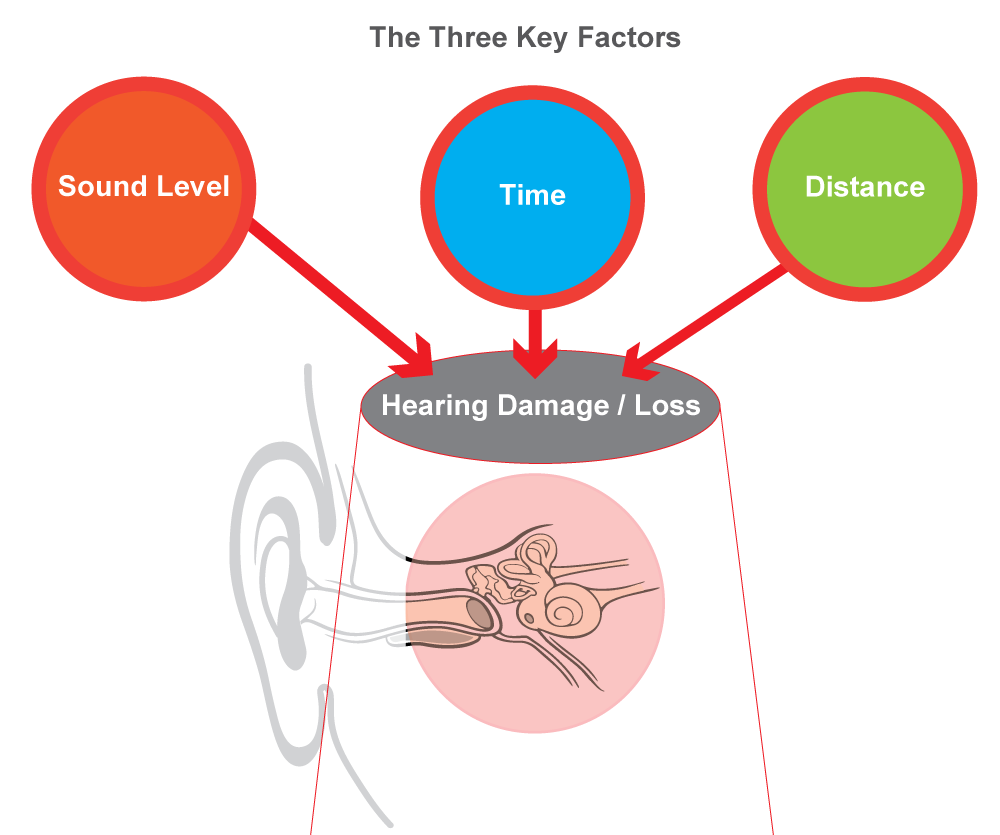Noise Exposure & Hearing Damage
How loud is too loud?
The loudness of sound is measured in decibels (dB). The scale is given a weighting of dB(A) after correction for the perception of the human ear.
The scale ranges between 0 dB(A) to 180 dB(A)–representing the softest sound the human ear can detect to the blasting noise from a rocket launch at the two extremes, respectively. It is important to also note that Decibels are logarithmic–meaning that, if the dB level rises by 10, the loudness of sound rises tenfold.
Everyone’s sensitivity to sound is different. Generally, sound intensities higher than 80 dB(A) can impair hearing. As a rule of thumb, when you have to raise your voice in order to be heard in a noisy environment, the background noise level is 80 dB(A) or higher.
There are three key factors that affect whether and by how much a sound will damage your hearing:
- Decibel level: How loud the sound is.
- Distance: How close you are to the source of the sound.
- Time: The length of time you are exposed to the sound.

Exposure to excessively loud noises for even a short time, such as an explosion or gunfire, can lead to instant and even permanent hearing loss. However, hearing loss is generally more likely to result from sounds that aren’t as loud but you are exposed to repeatedly for long periods.
Some examples of noisy activities that could damage your hearing are:
- Listening to loud music through headphones, at a concert, or while you’re playing an instrument
- Going to the movies or cranking up the volume on the TV at home
- Cranking up the volume on the stereo in the car
- Going to sporting events attended by large, noisy crowds
- Going to fireworks shows
- Working with loud power tools
Your hearing might return to normal a day or two after you’ve been exposed to loud noises. Recent research suggests, however, that your hearing can be permanently damaged even if you don’t have noticeable hearing loss right away.

Noise damage: Key facts (World Health Organisation)
○ 1.1 billion young people worldwide at risk of hearing loss due to unsafe listening practices
○ Over 43 million people 12-35 years old live with disabling hearing loss
○ Among young people 12-35 years old in middle and high income countries:
● Nearly 50% listen to unsafe levels of sound through personal audio devices (MP3 players, smartphones, and others..)
● Around 40% are exposed to potentially damaging levels of sound at nightclubs, bars and sporting events
Warning signs of noise damage
Because noise induced hearing loss can build slowly over time, you might not notice the early signs of hearing loss. As your hearing gets worse, certain sounds–particularly speech–begin to sound muffled. As a result, you may experience:
- ✓ Noise becoming painful
- ✓ Tinnitus: ringing/ buzzing/ other sounds in the ears
- ✓ Sounds generally heard being more quietly than usual
- ✓ Asking others to repeat themselves more often
- ✓ Difficulties hearing conversation in noisy environments
- ✓ Problems hearing over the telephone
- ✓ TV volume going up
How to prevent noise damage?
- ✓ Keep the volume down
- ✓ Limit the time spent in noisy activities
- ✓ Invest in hearing protection products to use when in loud noisy environments
- ✓ Heed the warning signs of hearing loss
- ✓ Monitor safe listening levels through smartphone apps
- ✓ Get regular hearing check-ups




